



People who are leaving Tata Steel and those joining it show that the flow of talent is suddenly becoming border-less, Atrayee Sanyal, VP of HR Management at Tata Steel, tells Moneycontrol in an exclusive interview.
Till date in FY23, managerial attrition is around 7-8 percent. However, the HR chief asserted that those who have assimilated into Tata Steel’s culture stay back. “From our core area of operations, maintenance, shared service, engineering, and projects, the attrition is very low,” she said.
The average age of employees at Tata Steel is around 41 years. “If they join at age 22, you would say people have lived around 19-20 years in the organisation,” Sanyal said. Currently, 92 percent of the senior leadership are those who have spent around 22-30 years on average at the company, depending on the leadership level.
Edited excerpts:
Q: How do you think the expectations of talent have changed in the heavy industry?
A: Earlier, we used to think that we are a protected company and that we will not get affected by people moving in and out, people wanting to do new things and being very choosy about their jobs. That has been proved wrong.
It's like diamond-mining now. You are waiting to see how you protect and polish your diamond (workforce) and what it is that people want. The buzz word, which we thought was only for the IT industry, called flexibility, choice, and pay per hour, are coming into manufacturing also, though to a limited extent.
Also Read | Tata Technologies used continuous learning, higher increments to stem attrition: HR chief
People who are leaving us and an equal number who are joining us show that the flow of talent is suddenly becoming border-less. Now it doesn't matter whether you stick to a job – the definition of loyalty. This used to be a holy cow in the past. It is changing.
Q: How are you polishing your ‘diamonds’?
A: People usually leave for better career opportunities in locations of their choice, with higher pay. I don't think the needle moves too much as you go up the ladder but challenging opportunities in locations of their choice is where I think we had the biggest disadvantages. Noamundi will remain Noamundi. You cannot change its look and feel. How is it in these conditions you become an employer of choice?
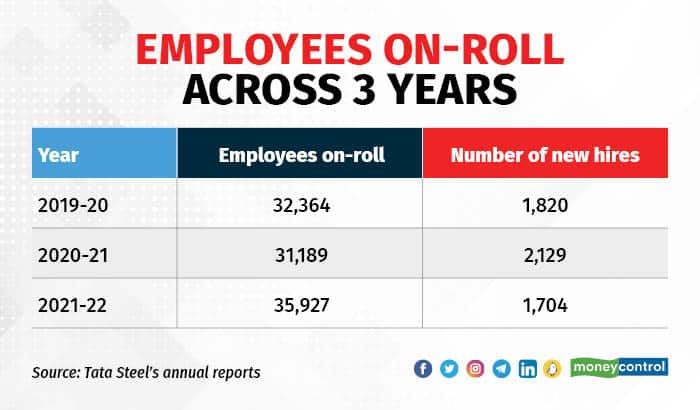
Just as COVID kicked in, we had two modes of working -- flexible and working from home (WFH). Imagine a manufacturing organisation whose white-collar workers operating in these modes, and around 5-10 percent operating from any location. This was not done in the organisation ever before.
Secondly, we allowed people to pursue projects different from their line of work based on their interests. For instance, an employee working on greenfield projects can learn the working of corporate communications. Around 70 percent of our jobs are filled up in-house, and only 30 percent come from outside.
Thirdly, we thought of making ‘digital twins’ of blast furnaces or sinter plants. In the pilot mode, we started with our sinter plant, which is outside the main works area and is controlled totally from a building that used to be occupied by people who now work from home. Now, we are thinking of digital twins of other parts of the chain of production.
Hence, WFH might not be a thing for white-collar people only.
Also Read | How Ericsson is gearing up to attract and retain talent in the 5G world
Fourthly, we have a gig policy which is unheard of in manufacturing. It allows people of expertise – R&D, medical, ceramics specialists etc., to come in, give their expertise and then move out.
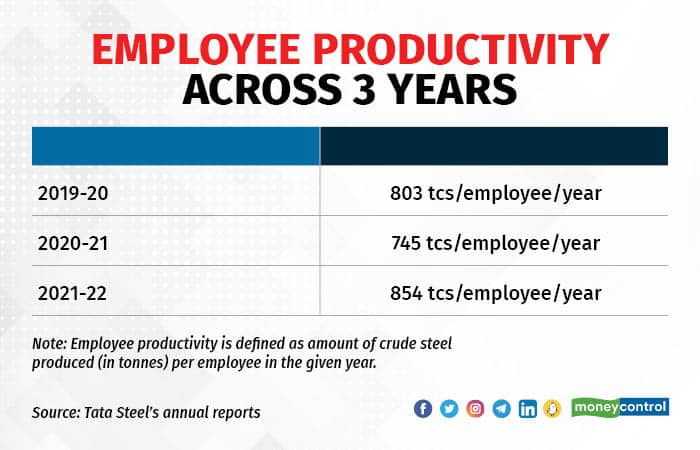
Q: You said some trends from the tech sector have reached manufacturing. What is Tata Steel’s views on moonlighting? How do you see the issue as an HR leader?
A: Tata Steel hasn't taken a stand on moonlighting because we have not yet faced it. Moonlighting is possible when the knowledge is such that it can be replicated in equal measure in any other industry or any other company. We have a very strict clause that you can be employed only in one organisation for sure. Concurrent employment is against the Tata Code of Conduct.
My view, as an HR thought leader and in my individual capacity, is that just like there is ethical hacking, there can be ethical moonlighting. It is only to the advantage of broadening the horizon of people who want to experience something new.
Companies can define new thresholds of loyalty, and design better pay packages for ethically moonlighting people because you want them to moonlight, go out and experience while being loyal to your organisation.
Q: Anything else you want to add, concerning the digital transformation at Tata Steel?
A: We have around 75,000 contract labourers and their well-being is primary for us. Our digital platform, ‘Connected Workforce’, is like a Google Map, and everybody carries a ‘Suraksha’ card.
As soon as any worker is entering a high-hazard area or a place where they are not supposed to be, an alert goes to the quick response team (QRT). Just imagine having so many cameras at multiple manufacturing locations to see that people are protected.
Also Read | ‘The Great Attrition’ is ebbing, there’s stability in people movement now: KPMG India
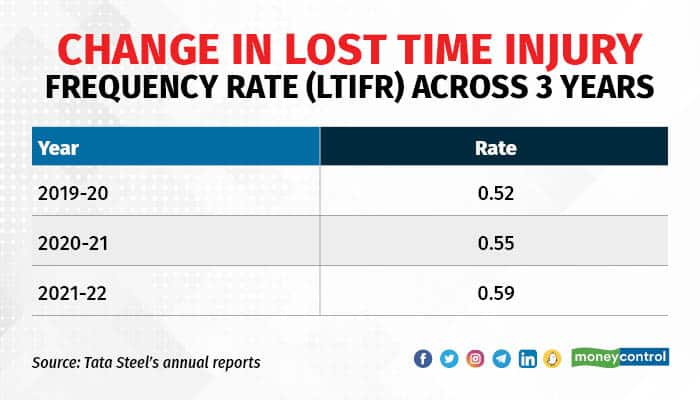
Q: What is the rate of attrition and how do you predict the future in this regard?
A: Overall attrition used to be somewhere around 4 percent. Among officers, non-managerial cadres used to have around 1 percent and managerial cadres would be around 5-6 percent. This year (till date in FY23), managerial attrition is around 7-8 percent. In certain functions, like HR, procurement, finance, IT and corporate services, the attrition rate is as high as 12 percent.
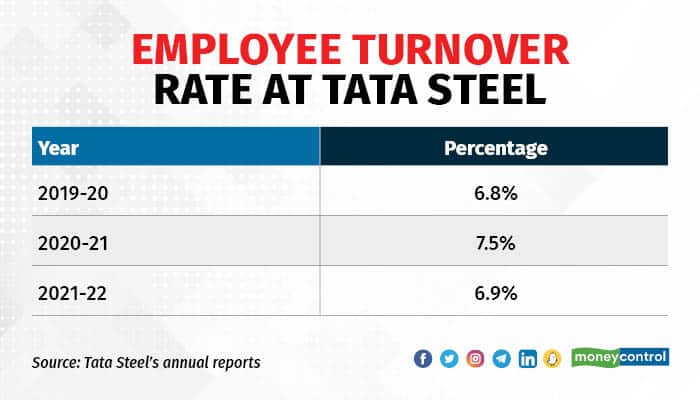
The hypothesis in my mind is very clear: people who are industry-agnostic and can wedge out using their knowledge space in any other industry will be choosing what is available to them in the best location they want.
I mean you’ve got to be thinking why a person will work in Kalinganagar when they have a choice in Amazon Bengaluru, when his/her parents are staying in Bengaluru, okay?
Most importantly, those who have assimilated into Tata Steel’s culture stay back. We have the attrition of the younger workforce. But from our core areas of operations, maintenance, shared service, engineering, and projects, attrition is very low.
Also Read | When it comes to talent, versatility is the name of the game: TVS HR chief
Q: Can you please throw some light on the diversity and inclusion (D&I) agenda at the company?
A: When we entered into the diversity journey, it was only women. Now, the focus is on diversity of at least four kinds – gender, tribal communities, LGBTQ+ and persons with disabilities (PwD). In the PwD category, we will focus on visually, orthopedically, hearing and speech-impaired people. I'm personally studying neurodiversity and the areas of the company that can focus on neurodiversity.
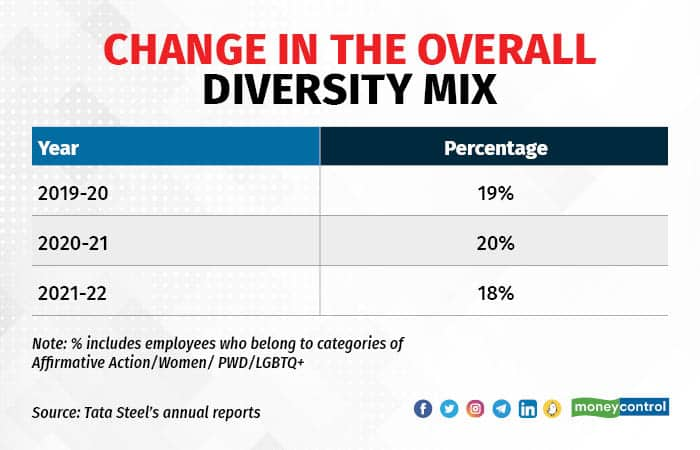
When we started a few years back, we had around 3.8 percent women, overall. The overall diversity mix (gender, tribal communities, LGBTQ and PwD) was somewhere around 16 percent.
We've now jumped to around 19 percent of overall diversity. Though the women's percentage has dropped a little bit, we're not worried about it because our recruitment of women is more than 40-45 percent in numbers.
Q: Please share more details on the initiatives.
A: On the recruitment front, we have decided to on-board 40-45 percent of women or diverse people. Further, we have a ‘Women of Mettle’ programme where we catch females young in the second year of their engineering degree through a contest. It gives us 1,300-1,400 CVs of women every year from engineering colleges for manufacturing. Around 50 of them make it to the competitions and eventually 10 of them get selected every year.
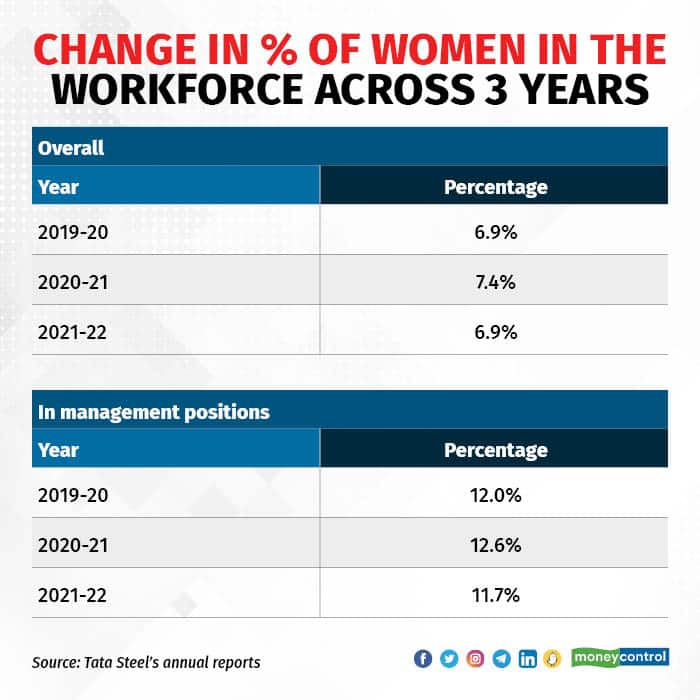
We also have gone into transgender hiring in a big way. This is the reason why I call Tata Steel ‘the agile gentle giant’ because, within eight months, we had 100 transgenders enter the workforce. We have put efforts from sensitisation to changing their medical policy to making hormone treatment available and training them for their roles.
On the managerial level, we recruited 10 transgenders throughout the ‘Queerious’ contest in business schools and got a database of more than 280 people.
Also Read | India is a strategic location for global talent search: Citigroup hiring chief
For retention, there are a host of policies, such as allowing women to travel with their small babies and maids at the workplace, adoption leaves for trans communities, parental leave for single fathers equivalent to maternity leave, etc.
We are restricted by one thing by the government – there are no night shifts allowed for women in Jharkhand, which is our major area of operations. Just last month, we got permission in Kalinganagar in Odisha. Once it changes, we'll have more bandwidth to take women.
Q: Can you share a ballpark number concerning how many people are with Tata Steel for over 10-15 years?
A: You must have heard our CEO TV Narendran speaking in various forums that we have six generations of people working. More than 45 percent of our workforce has been with the company for more than 10 years. This is despite the fact that we have done massive hiring in the last few years and have added significant number of people to our workforce.
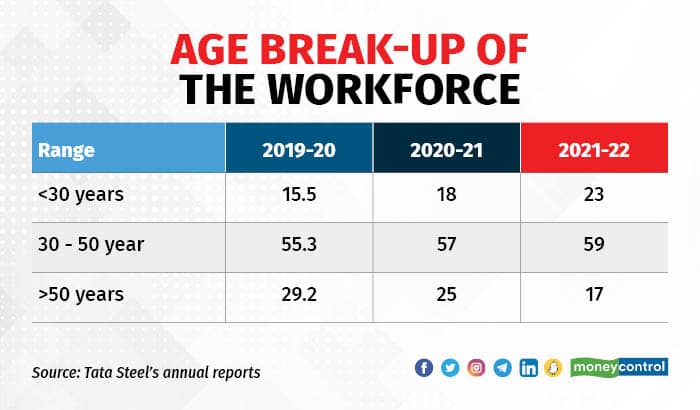
Currently, 92 percent of our senior leadership are in-house and they have stayed on. The average age that a leader spends is around 22-30 years, depending on the leadership level.
Q: How has the working model evolved at Tata Steel? What does the future look like?
A: We are largely a physical company. If any employee wants to operate four days from the office and one day from home, it is allowed. That mode is available to 100 percent of our white-collar officers. Overall, not more than 5-7 percent of our people are on absolute work from home, mainly in IT and procurement.
Besides, there is no attendance– people are free to go, and the intimation goes to the superior. Then you don't have to swipe a card to enter your office. All that is gone.
Also Read | We’re not 107 years old, we’re 107 years new: Tata Power CHRO Himal Tewari
We have left it largely to the managers and advise them to “please do not do away with flexibility” but utilise it in a manner that the organisational deliverables don't come in the way.
[This interview has been edited for length and clarity]
Discover the latest Business News, Sensex, and Nifty updates. Obtain Personal Finance insights, tax queries, and expert opinions on Moneycontrol or download the Moneycontrol App to stay updated!